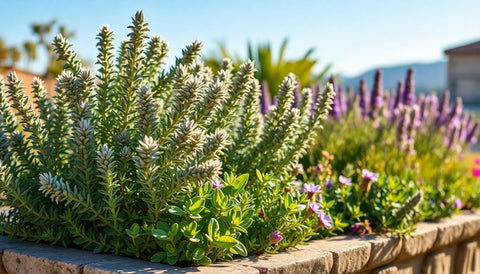Introduction
Sage is a multifaceted herb that has woven itself into the fabric of history with its diverse uses. From culinary delights to medicinal concoctions and even ornamental displays, sage is an invaluable addition to any home or garden. Its rich historical significance, revered by ancient civilizations for its healing properties, intersects seamlessly with its role in contemporary gardens, providing flavor, remedy, and beauty.
This guide aims to delve deeply into the intricacies of sage care. Whether you are a seasoned gardener or a budding enthusiast, this comprehensive guide will provide you with all the necessary insights to cultivate thriving sage plants. At Plantology, we believe that a well-cared-for plant is the cornerstone of a beautiful garden, and our expertise in plants and trees is at your disposal.
Section 1: Understanding Sage

1.1. What is Sage?
Sage, scientifically known as Salvia officinalis, belongs to the mint family, Lamiaceae. It’s a perennial, evergreen subshrub with woody stems, grayish leaves, and blue to purplish flowers. Native to the Mediterranean region, sage has become naturalized across the globe, owing to its resilience and adaptability.
1.2. Varieties of Sage
While Salvia officinalis is the most recognized variety, sage encompasses numerous species and varieties, each offering unique colors, textures, and aromas.
1.2.1. Common Varieties
- Garden Sage: The standard culinary variety used frequently in cooking.
- Purple Sage: Aesthetic with vibrant purple leaves, ideal for ornamental purposes.
- Tricolor Sage: Displays variegated leaves with colorful desaturation of green, cream, and pink.
- Pineapple Sage: Renowned for its sweet, tropical fragrance, and bright red blossoms.
1.3. Historical Significance
Sage has been treasured since ancient times for its culinary and medicinal qualities. The Romans used it to preserve meat and its antiseptic properties were valued highly. In medieval Europe, sage was believed to have spiritual properties capable of warding off evil. Through this rich tapestry of history, sage has always maintained its rightful place in herb gardens and homes.
Section 2: Growing Sage

2.1. Ideal Growing Conditions
Sage thrives in specific conditions and understanding its needs will allow you to harness its full potential.
2.1.1. Soil Requirements
A well-draining soil is crucial for sage. Sandy, loamy soil enriched with organic matter offers the best growing medium. Aim for a soil pH of 6.0 to 7.0 to foster optimal plant health and growth.
2.1.2. Sunlight and Temperature
Sage flourishes in full sunlight, requiring at least 6 hours of direct sunlight a day. It prefers moderate temperatures but is quite hardy, tolerating a variety of climatic conditions including light frost.
2.2. Planting Sage
Planting sage at the right time and with the correct spacing enhances its growth prospects. It's best to plant sage in the spring after the last frost.
2.2.1. Spacing and Depth
Space sage plants approximately 18 to 24 inches apart to ensure ample airflow and room to grow. Plant seeds about 1/8 inch deep or transplant seedlings at the same soil depth they occupied previously.
2.3. Sage in Containers
Sage is well-suited for container gardening, making it ideal for patios and balconies. Choose a pot with adequate drainage, and ensure the soil mix retains moisture without becoming waterlogged.
2.3.1. Selecting the Right Pot
Opt for containers that provide a minimum of 8 inches in diameter and depth. Terra cotta pots are particularly effective as they allow for better moisture management.

Section 3: Caring for Sage
3.1. Watering Sage Plants
Sage is relatively drought-tolerant once established, but young plants need regular watering. Allow the top layer of soil to dry between waterings to prevent root rot.
3.2. Feeding and Fertilizing
Sage doesn’t require heavy feeding. Apply a balanced general-purpose fertilizer in spring to support new growth. Be cautious not to over-fertilize, as this can lead to excessive leaf growth with reduced flavor.
3.3. Pruning and Maintenance
Regular pruning is key to maintaining a healthy, bushy sage plant. Trim back after flowering and remove any woody, dead stems to stimulate new growth.
3.3.1. Harvesting Tips
Sage leaves can be harvested year-round, but their flavor is best just before flowering. Harvest leaves in the morning when oils are most concentrated, and never prune more than half of the plant at once.
Section 4: Troubleshooting Common Sage Problems
4.1. Pests and Diseases
Sage is generally resilient against pests, but occasionally aphids, spider mites, and whiteflies may infest. Natural remedies such as neem oil or insecticidal soap can help control these pests.
4.2. Preventing Rot and Mildew
Good airflow and proper watering are critical in preventing issues like root rot and powdery mildew. Ensure your sage plants are not overcrowded and remove dead leaves that may harbor fungal spores.

Section 5: Utilizing Sage
5.1. Culinary Uses
Sage enhances dishes with its robust, earthy flavor. It is a classic ingredient in stuffing and pairs beautifully with poultry, pork, and sausage. Sage can be used fresh or dried, retaining its aromatic properties.
5.2. Medicinal Benefits
Traditionally, sage has been used to soothe inflammation and provide relief from sore throats and digestive issues. Modern herbal medicine still values sage for its antioxidant, anti-inflammatory, and antimicrobial properties.
Conclusion
Sage is an herb of infinite charm and utility, a staple for any passionate grower who seeks a blend of beauty, taste, and healing in their garden. Understanding the specific needs and nuances of caring for sage opens up an enriching journey of gardening and culinary experiences.
Enhance your gardening endeavors with the variety of plants available at Plantology. Discover exquisite options such as the Adonidia Palm Double or the vibrant Agapanthus Lily of the Nile Blue to complement your garden's herbal haven.
Visit our Plantology Online Store to explore our full range of beautiful and high-quality plants, perfect for every type of garden and gardener.
Expanding Your Sage Garden
6.1. Companion Planting with Sage
Integrating sage into your garden involves more than merely planting it in isolation. Sage is an excellent companion plant for many other herbs and vegetables. It repels common pests and can enhance the growth and flavor of neighboring plants.

6.1.1. Beneficial Companions
- Rosemary: Both herbs thrive in similar conditions, making them natural partners in the garden.
- Tomatoes: Sage can help deter pests like hornworms that often plague tomato plants.
- Carrots: Sage masks the carrot's scent, protecting it from carrot flies.
- Cabbage: It repels cabbage moths, providing natural pest control for this cruciferous plant.
6.2. Aesthetic Options for Sage Landscaping
Sage's diverse varieties offer a spectrum of colors and textures that can elevate any garden design. Its blooms and foliage provide a beautiful aesthetic element in landscape planning.
6.2.1. Ornamental Choices
- Golden Sage: Its variegated golden leaves present a striking visual contrast against darker foliage.
- Azure Blue Sage: The blue blooms add a vivid splash of color during the flowering season.
- Mexican Bush Sage: This variety offers stunning purple flower spikes that attract pollinators such as bees and butterflies.
Preserving and Using Sage
7.1. Harvesting and Storing Sage
The art of harvesting and preserving sage can allow you to enjoy its benefits year-round. Once properly stored, sage retains its flavor and medicinal properties remarkably well.
7.1.1. Drying Methods
For drying sage, hang small bunches upside down in a dry, well-ventilated area. Alternatively, use a dehydrator on a low setting for a quick solution. Once dried, crumble leaves and store them in an airtight container for extended shelf life.
7.1.2. Freezing Techniques
Chop fresh sage leaves and freeze them in ice cube trays with a bit of water or olive oil. This method helps preserve the fresh flavor and makes it easy to use small amounts when needed.
7.2. Sage in Traditional Medicine
Sage's healing properties have been acknowledged across numerous cultures and medicinal traditions. It is often used in tinctures, teas, and infusions.
7.2.1. Strategies for Use
- Sage Tea: Boil fresh or dried leaves in water to create a soothing tea commonly used for sore throats and indigestion.
- Sage Tincture: A concentrated syrup made by soaking sage leaves in alcohol, used for its anti-inflammatory and immune-boosting effects.
- Aromatherapy: Sage essential oil, when diffused, offers calming effects and stress relief.
Global Culinary Influence of Sage
8.1. Sage in World Cuisine
Explore the culinary journey of sage that spans cultures and continents, each with unique methods to incorporate this aromatic herb into their traditional dishes.
8.1.1. European Cuisines
In Italy, sage is essential in rich butter and herb sauces known as salmoriglio. In French cuisine, it's part of the classic bouquet garni, enhancing dishes like coq au vin.
8.1.2. North American Dishes
Sage is indispensable in Thanksgiving stuffing and others such as pork or turkey recipes. Its earthy flavor complements hearty dishes, making it a beloved staple in seasonal cuisine.
8.2. Experimental Recipe Ideas
Experimenting with sage in the kitchen will open new culinary doors, enhancing both traditional and modern dishes.
8.2.1. Savory Pairings
For a savory touch, try creating a sage-infused olive oil by warming a few sprigs in oil over low heat. This fragrant oil is a perfect drizzle over grilled vegetables and homemade soups.
8.2.2. Sweet and Herbal Fusion
Sage can also add depth to desserts. Infuse sage in cream to create a unique herbaceous panna cotta or blend with honey for a delightful addition to tea and pastries.
Innovation in Sage Usage
9.1. Sage in Modern Research
Emerging research continues to unlock new potentials for sage in both dietary and medicinal contexts, validating traditional uses with scientific insight.
9.1.1. Cognitive Benefits
Studies have shown that compounds in sage may improve memory and focus, igniting interest in its potential use for cognitive health supplements.
9.1.2. Culinary Innovation
Researchers explore sage as a natural preservative due to its antioxidant properties, which could extend the shelf life of certain foods while naturally enhancing flavor.

9.2. Environmental Benefits of Sage Cultivation
Sage cultivation can contribute positively to environmental sustainability. Its drought-resistant nature makes it an excellent choice for xeriscaping, a landscaping method that reduces water usage.
9.2.1. Wildlife Support
By planting sage, you can create a habitat for pollinators, thus supporting local ecosystems. Specifically, the brightly colored varieties of sage serve as crucial resources for bees and hummingbirds.
Conclusion & Further Exploration
Sage, a plant revered not only for its aromatic leaves but also its multifaceted roles throughout history and culture, continues to be a garden staple due to its adaptability, resilience, and diverse uses. Whether cultivated for its culinary prowess, medicinal benefits, or purely ornamental appeal, sage represents a blend of tradition and innovation. By familiarizing yourself with the growing techniques and creative uses of sage, your garden and culinary recipes will surely thrive.
At Plantology, we invite you to explore an array of plants that complement sage's unique properties. Consider the ethereal Lavender Lavandula, which shares many growing conditions with sage, or indulge in the lush, tropical appeal of the plant world's exotic set like the Bird of Paradise.
Enrich your gardening experience with our expertly curated selections available at the Plantology Online Store. Discover new plants to enhance your garden's diversity, and join us on a botanical journey filled with knowledge, beauty, and excitement.
``` By elaborating on these sections, this extended content aims to provide an in-depth look into various aspects of sage, offering practical, historical, and innovative perspectives on cultivating and utilizing this wonderful herb.






























Comments (0)
There are no comments for this article. Be the first one to leave a message!